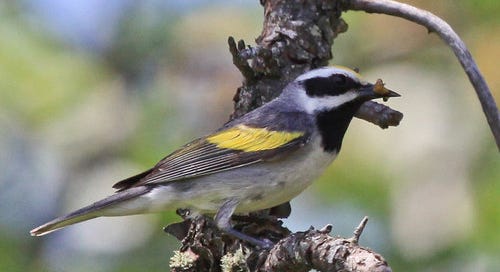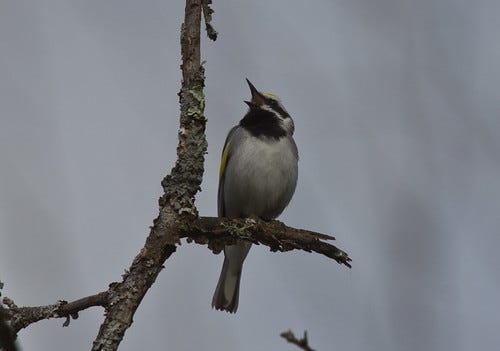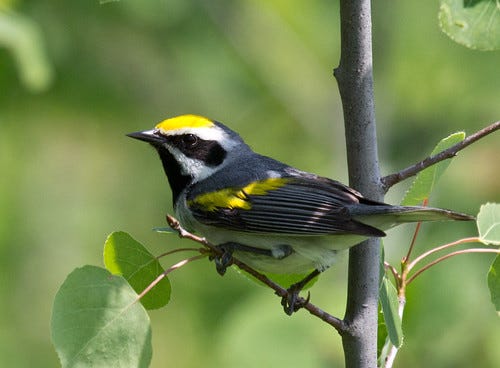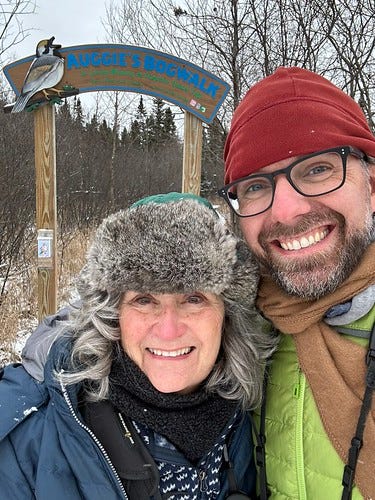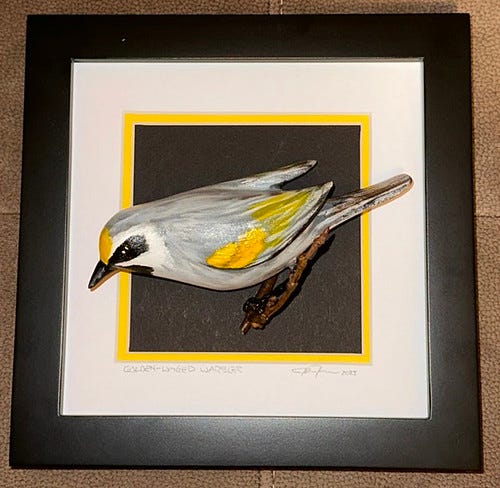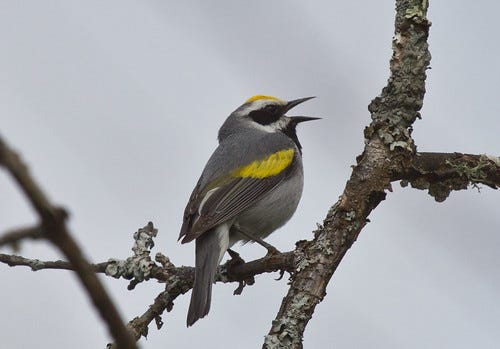(Listen to the radio version here.)
During spring migration when I was a teacher in Madison, Wisconsin, I’d wake up at 4 o’clock every weekday morning and head to my favorite birding spot, Picnic Point on Lake Mendota. I’d have to tear myself away by 7:30 so I could make it to the bus stop half a mile from the park entrance to get to school on time. As warblers started appearing in late April and early May every year, it got harder and harder to leave, but I only missed the bus once. On Thursday, May 5, 1977, I heard the unmistakable buzzy song of a Golden-winged Warbler—the very first one I’d ever heard in real life rather than on a recording. Hearing it was splendid, but I had to see the bird to add it to my life list. The bird kept singing and I kept searching, minute after minute. Finally, for one brief and shining moment, there it was! It didn’t stay out in the open for more than a few seconds, and then whoosh—both the little bird and I were off!
I ran as fast as I could, but while I was still a good block away from the bus stop, I saw my bus whiz by. The next bus wouldn’t come for half an hour, so I had to run the whole two and a half more miles to get to school on time.
I’m not much of a runner, but I had been on the college fencing team at Michigan State just two years before and was still in pretty good shape.1
Running so far wasn’t easy, but at least I didn’t poop out. Some of my middle-school students saw me from a passing school bus, so I waved. I found out later they were taking bets about whether I’d make it before the bell rang, but I got there with enough time to spare to change into a skirt (which we women teachers were required to wear back then), wash my face, comb my hair, and be standing at my classroom door smiling as the first kids walked in. Never bet against a birdwatcher.
Never bet against a birdwatcher.
Was that 2 ½ mile run worth it for a momentary glimpse at a bird? It sure was! From directly beneath, Golden-winged Warblers look a lot like chickadees with their black bib and white lower cheeks, though they lack the chickadee’s buffy sides.
But even a tiny glimpse from the side, above, or face on of a singing male reveals the ethereal golden yellow that gives this stunning bird its name. Even though Minnesota is the epicenter of their breeding range now, I don’t get to see Golden-wings nearly often enough.
The Golden-winged Warbler is one of the rarest American birds not listed as endangered or threatened, suffering one of the steepest population declines of any songbird species in the past half century. The North American Breeding Bird Survey estimates an overall decline between 1966 and 2014 of 68 percent. Now the breeding range is split into two distinct regions, with 95 percent of the population in the Upper Great Lakes (mostly Wisconsin, Minnesota, and Manitoba) and the other 5 percent in the Appalachians from New York to Georgia.
I may live in the epicenter of their range, but Golden-winged Warblers are fussy about habitat. I lived in my house over 20 years before I finally added it to my yard list. In late May and June, I can usually hear one or two singing up at Hawk Ridge, which is less than ¾ of a mile from my house, so I’ve spent a few mornings pointing my parabola up there trying to pick out the song from my yard, to no avail.2
Golden-winged Warblers nest in shrubby, tangled thickets and other early successional habitats, so our young aspen forests are ideal, at least during the nesting period. But soon after the babies leave the nest, their parents lead them to mature forest habitats. Protecting them requires protecting a patchwork of two different habitats in the north.
We must also consider their wintering grounds in Central and northern South America, where they require semi-open woodlands including bird-friendly coffee farms under a forest canopy. Most coffee plantations destroy habitat for tropical birds, so the only coffee I buy is certified by the Smithsonian as “Bird Friendly.” 3
To celebrate the Golden-winged Warbler being named the American Birding Association’s Bird of the Year for 2024, even while they are thousands of miles away right now, on January 3, I got a selfie of Erik Bruhnke and me at the Sax-Zim Bog, standing under the Auggie’s Boardwalk sign, which has a gorgeous picture of a Golden-winged Warbler.
And when we went to the Visitor Center, there was a nice life-sized carving of a Golden-wing by John Jaranson which I couldn’t resist buying.
Come spring, I’ll spend some time trying to get some good recordings and more photos. The American Birding Association’s Bird of the Year may not be the biggest thing in the universe, but it’s a good reason to give this splendid bird a little more attention.
That was back in the days before the Big 10 had women’s fencing, but the men’s coach and players on the men’s team thought that was stupid. The coach didn’t get paid anything extra, and the men had to share their equipment with us, but it was great fun. When the men went to a match against a team that had its own unofficial women’s team, we got to play real, if unofficial, matches. Being on the team with them, we always worked out with the men, including running 5 miles several times a week. (This was before Michigan State hired and protected for such a long time the horrifying athletic doctor who now makes me ashamed to be associated with MSU.)
This is actually how I added American Woodcocks to my yard list. They used to display by the railroad tracks less than a half mile away, and though I could not pick out the sound with my ears, sitting on my roof with the parabola made it easy. If we can use binoculars to make birds look closer, why not a parabola to make them sound closer? (I’ve since seen a woodcock from my yard, once, in the little woodsy area right behind my yard.)
To get that certification, the coffee must be organic and grown under a natural forest canopy with excellent biodiversity. I order mine online from Birds & Beans.


